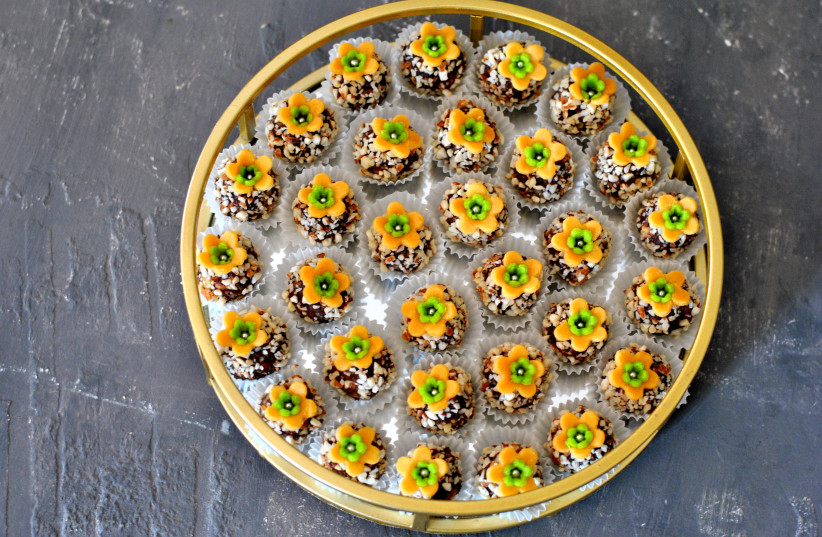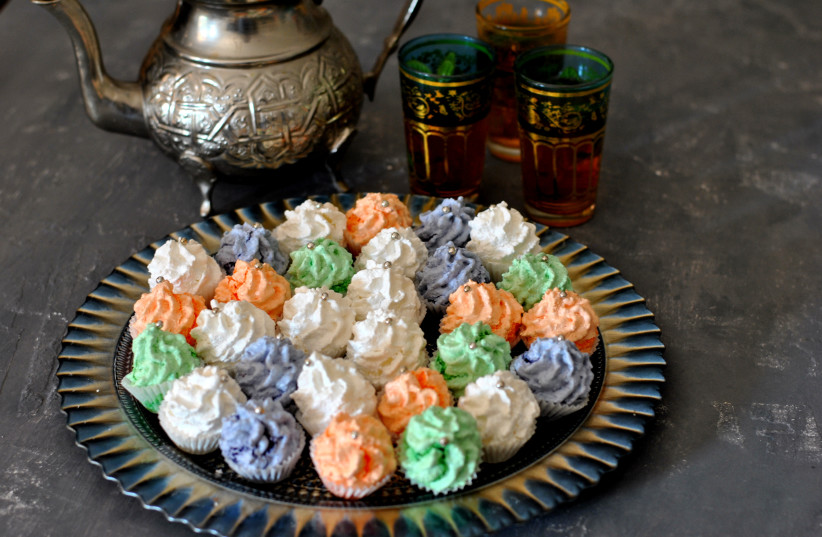If you’ve never been to a post-Passover Mimouna celebration, you have no idea what you’ve been missing. Mimouna is a Moroccan tradition that is celebrated by inviting friends and relatives over to enjoy table after table of prepared pastries and sweet treats that hail from North African Jewish cuisine. Traditionally, many of the cookies are adorned with marzipan flowers and mint leaves.
Mimouna is one of my favorite holidays of the entire year, especially since I have lots of experience with and good memories of the North African cuisine I was brought up with.
Traditionally, no meat is eaten at Mimouna celebrations, nor are sour, salty or black foods such as coffee, for fear of bringing bad luck. Only dairy and sweet foods made with milk and honey are eaten, as they meant to bring blessings, happiness, abundance and fertility to us all year long.
Not everyone knows this, but the Tripolitan Jewish community also holds Mimouna celebrations all together in the synagogue. Prayers are held, and then everyone is invited to partake in the festivities. In my family’s synagogue, they would prepare a large pastry they called the Mimouna that was made with hardboiled eggs that were held together with dough strips.

Every year, I like to offer my readers new ideas of desserts they can make for Mimouna. There is such a large variety of colorful cookies you can make with nuts, dried fruits and jams that are perfect for serving at the end of Passover.
Unfortunately, it seems like lately many people are posting pictures of cookies and pastries they’ve made with wheat flour that are hametz and not to be eaten on Passover. These desserts were either prepared before the holiday and frozen, or during the holiday, when it is forbidden to eat them or even have them in our homes, so that they can be ready in time for the Mimouna, which starts right as Passover ends.
I would like to mention that sfenj, chebakia and fazuelos were not served at traditional Mimouna celebrations. The only item made with flour that is supposed to be eaten at these parties are mufletas, which are made fresh on the spot, after Passover has ended.
Mufletas are customarily served with butter and honey spread on them, along with other goodies like zaban, which is white nougat with walnuts that is meant to make the coming year sweet. The nougat is so sweet that eating just a small bite of it is believed to lead to a happy and prosperous year.
All the rest of the goodies prepared for Mimouna are not made with wheat flour, so they are kosher for Passover. They are usually made with all sorts of nuts, coconut, sesame seeds, dried and fresh fruits, and jams. It is not unusual to see groups of women gathering together during Hol Hamoed so that they can prepare all the treats that will be served at the upcoming Mimouna.
One of my favorite pastimes is hosting well-known culinary professionals in my home kitchen so they can introduce me to their world of cooking or baking. This week, I asked Mimi Nidam, mother of five and grandmother of 11, who has an active Facebook page, to share with me about her love of this special Moroccan tradition, to which she has added her own unique and modern twist. She loves leading workshops in which she teaches young people about these ancient traditions.
In the home Mimi grew up, family life was centered in the kitchen, which was full of activity day and night. She fondly remembers her late Moroccan mother, Suzan, who produced enormous quantities of exceptional pastries by hand without any fancy equipment, scales or thermometers. Mimi remembers spending hours upon hours with her mother in the kitchen learning the ins and outs of Moroccan cooking and baking.
When Mimi got married, she began her own efforts to replicate all the tasty delights she loved from her childhood. Over the years, Mimi has become quite a skilled chef in her own right, and her family soon began relying on her to provide copious amounts of cookies for every family bar-mitzvah, wedding and brit milah celebration.
After her children grew up and left home, Mimi decided to fulfill her dream of opening a baking studio in her home in Ashdod where she conducts traditional Moroccan baking workshops for small groups (see Mimi Nidam on Instagram).
Below, you will find four of Mimi’s recipes for cookies that are perfect for serving at Mimouna celebrations. They include cookies made with marzipan, meringue, sesame and jam.
<br>Mimouna tradition
There are many ideas about the origin of the Mimouna tradition, one of which is that it was named after the father of Maimonides, who was a Sephardic Jewish philosopher and Torah scholar, since it is believed that he was either born or died on that day. Another theory is that Mimouna is connected to the Hebrew word emuna, which means faith. According to a third explanation, there is a line in a Mishna that says God brought the Jewish people from Egypt to a land flowing with milk and honey, which appear in many of the delicacies served at Mimouna celebrations.
Although the sweets seem to be the focus of the celebration, if you take a look at the center of the main table, you will most likely find a wide basket filled with flour (symbol of fertile soil) with five gold coins (symbol of wealth), five green broad beans and five dates arranged in the flour – five being the number of fingers in the hamsa, which, of course, brings us good luck. Alongside this basket, you might also find a large bowl of water with live fish swimming around inside of it, with fragrant mint leaves, a symbol of fertility.
Another featured item you will find on the Mimouna table is a plate stacked high with mufletas that have been slathered with butter and honey, and then curled up into a log shape. Mufletas are usually served with glasses of sweetened mint tea.
Women traditionally wear colorful dresses embroidered with silver and gold string, and the men traditionally wear white clothing and red fez hats. The front door of the house is supposed to be left open so that everyone should feel they are invited to join the celebration. The host takes a piece of lettuce that was dipped in milk and patting each guest on the head, which is meant to bring the recipient blessings of livelihood, health and lots of other good things.
<br>Marzipan cookies
Makes 25 cookies.
- 250 gr. peeled almonds
- 150 gr. powdered sugar
- 1 Tbsp. lemon juice
- 1 Tbsp. water
- 1 tsp. vanilla extract
- Gel or powder food coloring (red, blue and green)
- Paper cupcake holders, size 1.5 inch
- Cookie cutters
Grind the almonds in a food processor by using the pulse button a few seconds at a time until the almonds are smooth. Add the rest of the ingredients and mix using the pulse button until the batter is mixed well.
Transfer the dough to a bowl and cover with plastic wrap. Let the batter sit for 30 minutes until it becomes firm.
Separate the dough into a few bowls and add a drop or two of food coloring to each bowl and mix well. In the pictures below, you will see that I prepared green, orange and purple dough, and left one bowl without any food coloring. Form small balls from the marzipan dough or use special marzipan molds. Set a little bit of marzipan dough aside to be used to make leaves and flowers that you can attach to the balls. Use silver candies to attach them to the marzipan balls.
Level of difficulty: Easy.
Time: 1 hour.
Status: Parve.

Hazelnut date balls
Makes 50.
- 1 package (500 gr.) pitted dates
- 2 Tbsp. water
- 200 gr. chopped hazelnuts (or other type of nuts, as long as it’s just one type)
- 1 tsp. cinnamon
- Pinch of ground cloves
Toppings:
- 50 gr. chopped hazelnuts
- Marzipan, shaped into small flowers
- Paper cupcake holders, size 1.5
Place the dates and water in a microwavable bowl and heat for a few seconds in the microwave. Mix well. Add the nuts, cinnamon and cloves and mix well.
Form small balls from the date mixture and then roll them in the chopped nuts. To prepare the marzipan flowers, roll out the marzipan dough, and then use flower-shaped cookie cutters to cut out the flower shapes. Place the marzipan flowers on the balls, then place each ball in a cupcake holder. Alternatively, you can form the balls in any shape you desire (see pictures below for ideas).
Level of difficulty: Easy.
Time: 30 minutes.
Status: Parve.

Sesame hamsa cookies
Working with caramel dough and sesame seeds requires a bit of practice until you can understand the technique, but once you catch on, it’s actually quite simple to make these sesame hamsa cookies, which Mimi Nidam has so gracefully shared with us. The easiest way to make them, especially if this is your first time, is by using flower-shaped and hamsa-shaped silicone trays, which can be purchased in specialty shops.
Makes 8 cookies.
- 1 cup sugar
- 2 cups sesame seeds
Pour the sugar into a medium pot and heat over a low flame until it turns into dark brown caramel (be careful not to let it burn). Remove from the flame.
Add the sesame seeds and stir. Take a spoon and transfer caramel mixture to the silicone molds (no need to grease tray). Let them cool for at least 40 minutes and remove the cookies from the silicone trays.

Coconut cookies
Makes 50 cookies.
- 6 egg whites
- 1 packet of vanilla sugar
- 2.5 cups sugar (the size of a plastic disposable cup used for cold water)
- 3.5 cups ground coconut
- Gel or powder food coloring (red, blue and green)
- Paper cupcake holders, size 1.5
Topping:
- Silver candies
Whip the egg whites for 2 minutes using an electric mixer on medium speed until they become light and fluffy. Add the vanilla sugar, then increase the speed and gradually add the sugar. Mix another 8 minutes.
Fold in the ground coconuts. Pour the mixture into 2 or more bowls and add a drop or two of food coloring to each bowl or leave one of the bowls without any color. Gently mix, taking care not to deflate the batter.
Arrange the cupcake holders on a baking tray. Transfer the batter to a pastry bag fitted with a serrated tip and fill the cupcake holders with the batter. Then add a silver candy on top of each cookie.
Bake in an oven that has been preheated to 150 °C for 12 minutes. The cookies should be crunchy on the outside and soft on the inside.
Before taking the tray out of the oven, check that the outer parts of the cookies are firm. If they’re not, leave them in the oven another minute or two until they crisp up.
Level of difficulty: Easy-medium.
Time: 30 minutes.
Status: Parve.
Translated by Hannah Hochner.
